The College of Polymer Science and Polymer Engineering—A Brief 131-year History by Frank N. Kelley

Goodyear Polymer Center
The College of Polymer Science and Polymer Engineering has been a part of The University of Akron (UA) for 32 years, but its global recognition today reaches back to its roots in rubber, as does the University itself. Founded in approximately the same year that Benjamin Franklin Goodrich came to Akron and launched what was to become a giant worldwide industry based on rubber, the University grew in concert with the industry in the city of Akron, which became known as the Rubber Capital of the World.
Rubber is the “classic” polymer; a class of materials which is identified with the extremely long molecular chain-like structures, making up such diverse materials as plastics, adhesives, fibers, resins, coatings and, of course, rubber. Polymers are found in all living things, the most recognizable being cellulose and DNA, but are more pervasive than all metals, combined.
Charles Knight designed and taught the world’s first rubber chemistry university course in 1909 at Buchtel College, precursor to UA. He was followed later by Hezzleton Simmons as Professor of Rubber Chemistry, who was further distinguished by becoming the President of The University of Akron, as well as being the coordinator of the U.S. Government Synthetic Rubber Program during World War II.
Next came George Stafford Whitby as Professor of Rubber Chemistry, joined later by Maurice Morton, who then built the faculty and founded the Institute of Rubber Chemistry along with the University’s first PhD program. President Norman P. Auburn advocated this to the Ohio Board of Regents (UA became a State of Ohio University under Auburn). The Department of Polymer Science grew out of the Institute when it separated from the Chemistry Department in the late 1950’s, with Morton at its head.
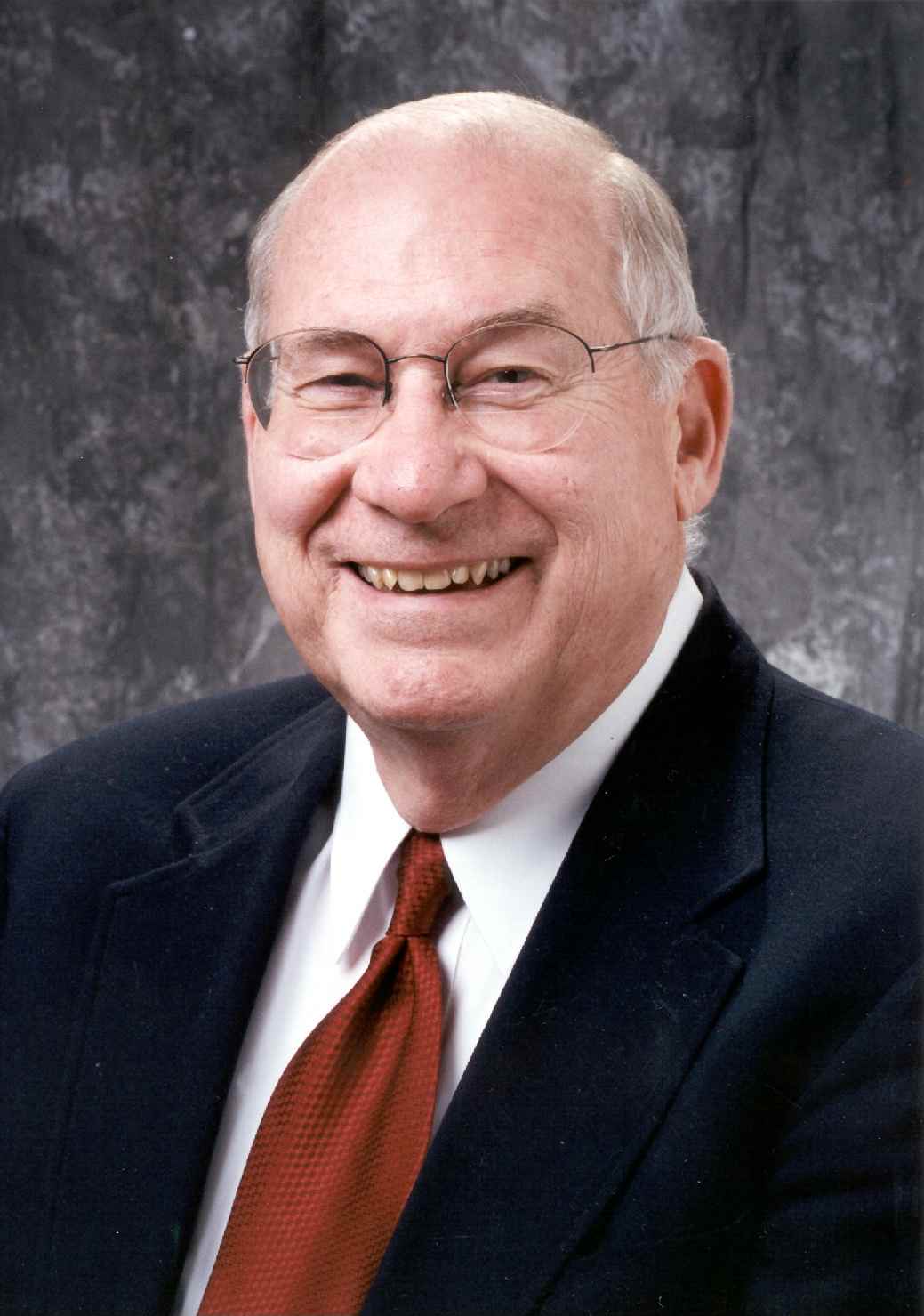
Dr. Frank N. Kelley
In 1978 when Morton retired, Frank N. Kelley, a 1961 polymer chemistry graduate of UA, was recruited as professor and director of the Institute, with the Polymer Science Department having a separate head. The department head position rotated in subsequent years throughout the faculty.
The Polymer program at UA was always supported and cherished by successive UA presidents, primarily because it was identified so strongly with the University and is known beyond the State of Ohio. The faculty that was assembled became renowned throughout the academic and industrial worlds for their research excellence. UA PhD and Master’s graduates were sought after and hired before the ink dried on their diplomas.
The College was formed under President William Muse in 1988 after a long-term plan received approval by the University Council and the Board of Trustees. Two years earlier Dr. Kelley had been part of a national study to understand why Polymer Engineering was not present on any campus in the U.S., while there were at least 83 Metallurgical Engineering departments in existence at the time. There were, however, a handful of academic departments specializing in polymer science; the distinction being that polymer science covered the chemistry and physics of polymers, but mechanical design, industrial processes and other engineering topics for polymers were largely neglected or imbedded in traditional engineering departments. This, while the total production of polymers in the world exceeded in weight and volume all metals combined. Kelley had been convinced that having university departments solely dedicated to the engineering aspects of polymer processes and products would be of great interest to industries and government. He had direct experience with this deficiency seeing the mistakes and high cost of materials and design failures in the aerospace industry. He had been the lead civilian scientist in two Department of Defense laboratories.
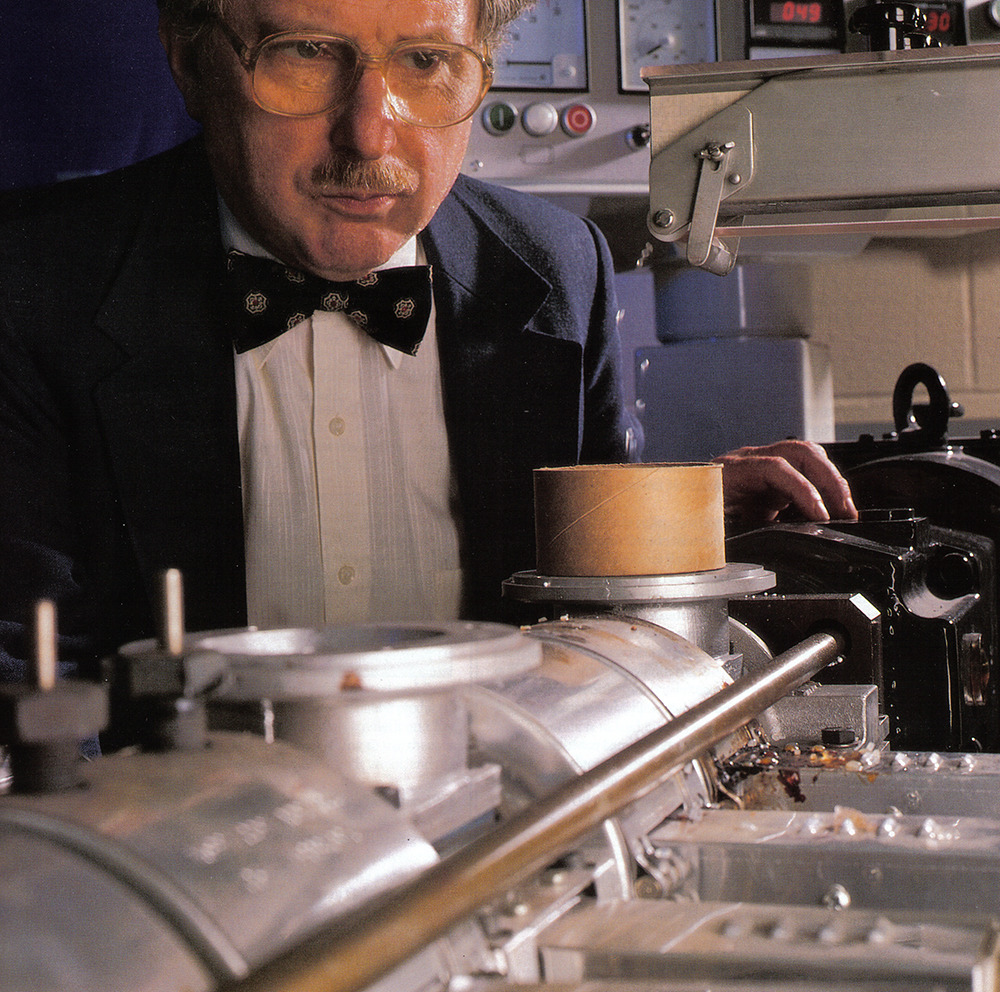
Dr. James L. White
Another individual who recognized this need was James L. White, a well-known engineering professor at the University of Tennessee (UT). Dr. White had industrial as well as academic experience in polymer engineering. He had hosted a meeting of the same National Research Council study as Kelley and they became friends and colleagues.
Shortly thereafter a new dean of engineering, Louis Hill, was appointed at UA. He was charged with increasing the research productivity of his college. Hill and Kelley were talking one day in Hill’s office and agreed to work together, in particular, on the polymer engineering topic. The question of how to get it started prompted Kelley to suggest hiring Dr. White from Tennessee. Hill immediately phoned Dr. White and invited him to the campus. White agreed that the idea was intriguing since he had little faculty and administrative support at UT. It took very little convincing when Kelley and Hill were joined for the initial dinner for White in Akron by the research Vice Presidents of Akron’s big four rubber companies: Goodyear, Goodrich, Firestone and General. All appealed to White to come to Akron. White decided to accept the offer and launched the Center for Polymer Engineering within the Chemical Engineering Department. The former Sydney Olson electronics warehouse on campus was made available to start the program. It was vacant and used for storage and band practice. A large and sturdy, but dismal space in need of renovation.
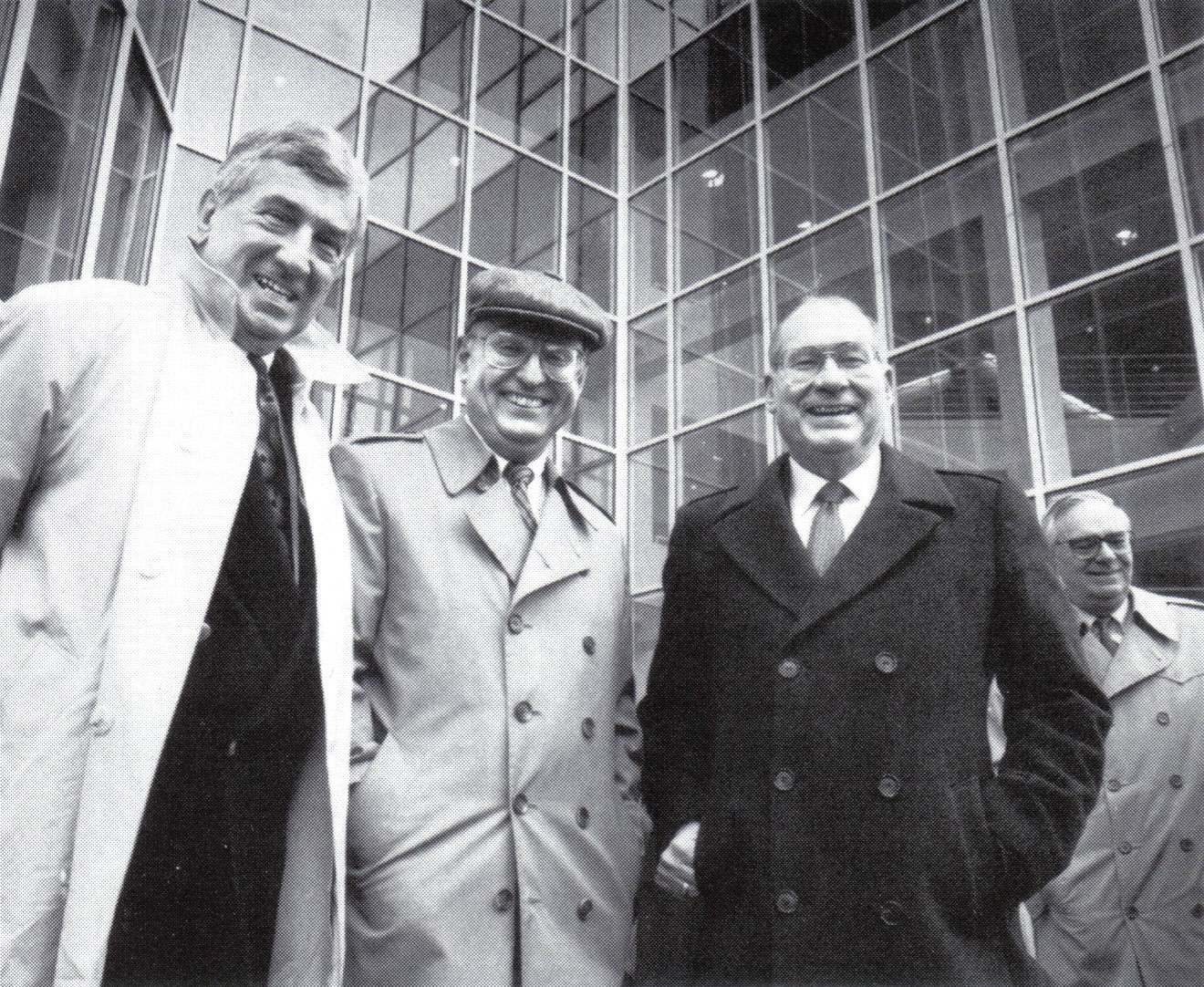
Dedication of the polymer science building, April 1, 1991. Pictured left to right are architect Richard F. Fleischman, President William V. Muse, Dean Frank Kelley, and Associate Dean Donald L. Bowles.
President Muse saw the prominence of the Polymer Institute as an opportunity to the advance the University’s position nationally by enhancing its physical facilities and began advocating a new building for polymer laboratories and classrooms. The College of Engineering was occupying the same building with the Institute of Polymer Science and had been growing cramped in the Norman P. Auburn Science and Engineering Center. Moving polymer science out of Auburn and nearby Whitby Hall would give the College of Engineering additional space and the new building would provide for Polymer Science. The Richard Fleischman Architectural firm was selected for the design and a site nearby was selected. The facility required raising substantial funds and the Industry responded with millions of dollars to supplement State funding. An imposing 12-story reflective glass building resulted which was dedicated on April 1, 1991. It was a state-of-the-art laboratory and classroom building that immediately became an icon for polymers in Akron. It was part of Akron’s skyline that could be seen from great distances.
Muse began another initiative that would have far-reaching consequences. One day he came to Kelley’s office and posed the question: “What would it take to bring the polymer program at UA to the front ranks of the world?” Kelley responded that it would take a large commitment, but if undertaken, could be achieved. Muse appointed Kelley to chair a temporary committee to develop a plan with the following questions charged to the committee: 1) Define “World Class” in this context. 2) What resources in terms of personnel and money would be required? 3) How would the needed money be raised? 4) What new organizational changes might be needed? and 4) Develop a timeline for accomplishment. Representatives on the committee consisted of the Polymer Science Department chair, the Polymer Engineering Center director, an associate Provost, and the deans of the College of Engineering and the Buchtel College of Arts and Sciences. After 9 months a plan was given to President Muse entitled: “A Polymer World-Class Center Master Plan.”
Implementing the plan would be a challenging and ambitious task, but several initiatives by the State of Ohio came into play. 1) The Thomas Edison Advanced Technology Center program, 2) The Ohio Eminent Scholars program and 3) Ohio Selective Excellence program. Each of these Ohio competitive programs were a source of funding that helped implement the plan. Matching funds were required with the polymer Industry once gain supporting the initiatives with cash and influence.
Shortly thereafter the University’s Futures Center sponsored a lecture and workshop with a renowned “futurist” Joseph Coates. He was briefed on the plan and pronounced it largely unattainable. This gave everyone involved additional resolve to prove him wrong. A critical partnership was stimulated by the Edison Centers program when the excellent polymer program at Case Western Reserve University (CWRU) joined The University of Akron in a Joint Industry-University organization entitled EPIC (the Edison Polymer Innovation Center). The center’s mission was to foster development of new products and industries (technology transfer) by Ohio’s substantial polymer research capabilities. Over 26 companies signed up. This organization persisted for over 10 years and caused a collaboration between two formerly competitive university polymer programs in many new ways.
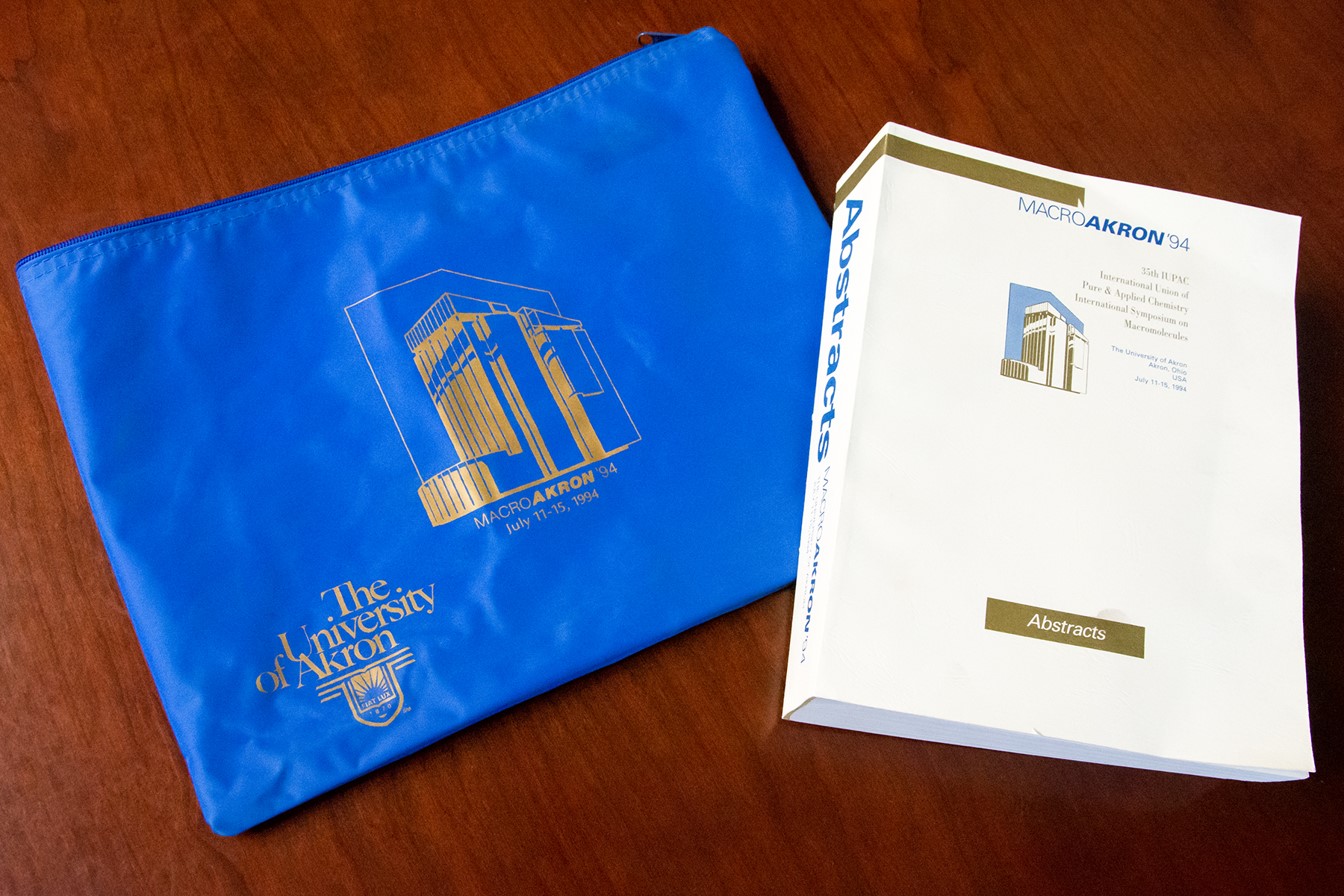
MACROAKRON materials and abstract book
In 1994, a UA/CWRU collaboration vaulted The University of Akron’s polymer program to achieve a national #2 ranking by US News and World Report. This was the Union of Pure and Applied Chemistry (IUPAC) Polymer Symposium held at UA and supported by CWRU. Entitled: MACROAKRON, it drew over 47 countries and over 1700 participating scientists and engineers to Akron. The Polymer Science building’s two glass towers loomed large over the conference headquarters.
A significant part of the World Class Center Master Plan was evolving at the time. That part had to do with the “Organizational Options” recommendations. It proposed combining the Polymer Science program from the Buchtel College of Arts and Sciences with the Polymer Engineering program from the College of Engineering and forming a new School of Polymer Science and Engineering. This proposal would wind its way through various committees, the University Council and miraculously passing all hurdles was forwarded to the President and Board of Trustees. The only change was that it was approved as a new College with the university structure, rather than a School. Its name was designated the College of Polymer Science and Polymer Engineering. The redundancy of the word “polymer” was due to the desire by the College of Engineering that the new college not be confused with all of Engineering, by giving it a specific, limited charter. Frank Kelley was named the founding dean, a position which he held for 18 years before his retirement.
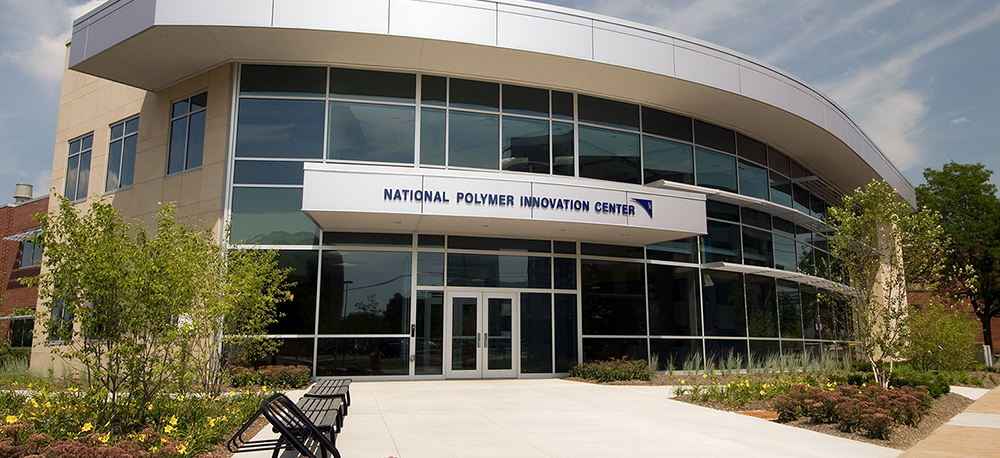
National Polymer Innovation Center
As the years have passed the College has had new leadership, a largely new faculty with new specializations such as bio and biomedical polymers, nanostructures, functional polymers, photonics, and electrospinning, to name a few. The Department of Polymer Engineering and its associated Institute are now housed in a newer building alongside the totally refurbished Sydney Olson Research building and an accompanying modern facility known as the National Polymer Innovation Center. The College has one additional facility: the Akron Polymer Training Center (part of Akron Polymer Technology Services) which focusses on industrial training, in addition to the Akron Global Polymer Academy which provides distant virtual learning capabilities. In recent years the “Polymer College” has counted as many as 38 permanent faculty and 350 graduate students and post-doctoral fellows. It has supplied industry and academe worldwide with over 2,000 PhD and Master’s graduates. The faculty included three members of the National Academy of Engineering, three Ohio Eminent Scholars, as many as 9 endowed and named chairs, several with the title of Distinguished Professor as well as Fellows of the National Academy of Inventors. Faculty patents, honors and other recognitions amount to thousands. Several successful companies have been launched from faculty, staff and student inventors. With its widely acknowledged status as one of the premier polymer academic units in the world, it is at the pinnacle and is, by far, the largest polymer program in the U.S.
A complete and accurate history of the rubber and polymer legacy at The University of Akron, up until ca. 2007, can be found in Chains of Opportunity by Mark Bowles published by The University of Akron Press.
